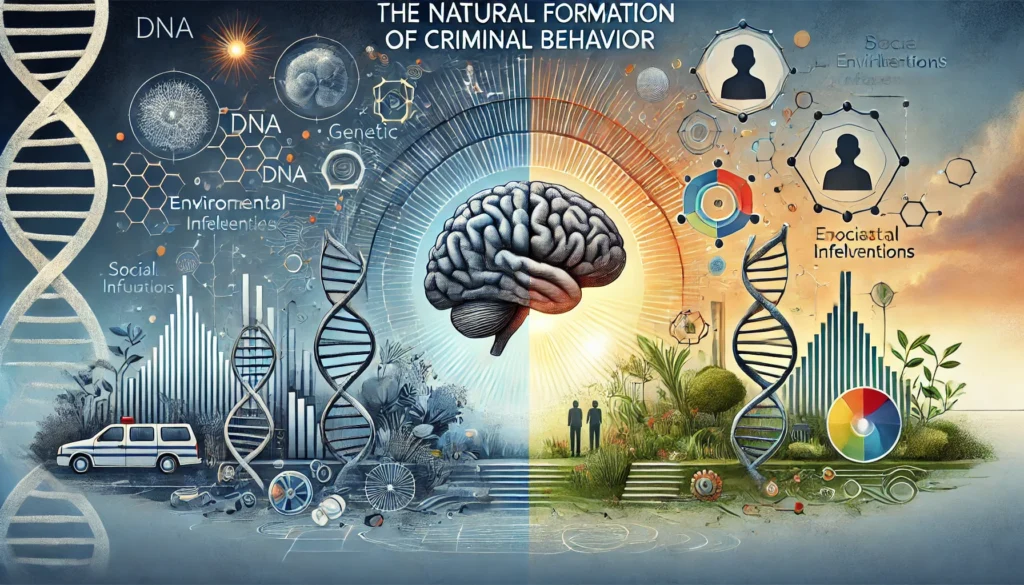The study of criminal behavior has long fascinated researchers, psychologists, sociologists, and criminologists. Among the many frameworks for understanding the origins of crime is the examination of natural and genetic factors. These elements, collectively referred to as the natural formation of the criminal, explore the biological and hereditary influences that predispose individuals to deviant behaviors. This article delves into these factors, analyzing their implications in criminology.
Understanding Natural Formation in Criminology
The natural formation of a criminal refers to the intrinsic factors contributing to criminal behavior. These factors include genetic predispositions, biological abnormalities, and hereditary influences passed down through generations. Unlike social or environmental contributors, natural formation emphasizes innate aspects of human behavior and physiology.
Historical Context of Natural Formation
The idea that crime has a biological basis dates back to the 19th century with the works of Cesare Lombroso, often regarded as the father of modern criminology. Lombroso’s “born criminal” theory proposed that certain physical traits, such as asymmetrical facial features or elongated limbs, indicated a predisposition toward criminality. Though his theories have largely been discredited, they laid the foundation for exploring biological explanations of crime.
Modern research has refined Lombroso’s ideas, focusing instead on genetic and neurological studies to understand criminal tendencies.
Genetic Influences on Criminal Behavior
Heredity and Criminality
Studies in behavioral genetics suggest that crime can be, to some extent, hereditary. Twin and adoption studies have provided critical insights into the genetic components of criminal behavior. For instance:
- Twin Studies: Research comparing identical and fraternal twins reveals that identical twins, who share 100% of their genes, show higher concordance rates for criminal behavior than fraternal twins.
- Adoption Studies: Studies examining adopted children demonstrate that those with biological parents who engaged in criminal activity are more likely to exhibit similar behaviors, even when raised in non-criminal environments.
Specific Genes Linked to Criminal Behavior
Recent advancements in genetics have identified specific genes associated with aggression and impulsivity, both of which are traits linked to criminal behavior. For example:
- MAOA Gene (“Warrior Gene”): Variants of the MAOA gene, which regulates neurotransmitters such as serotonin and dopamine, have been linked to aggressive behavior.
- DRD2 Gene: Associated with dopamine receptors, this gene has been implicated in risk-taking and impulsivity, characteristics often observed in criminal offenders.
While genetics play a role, it is crucial to acknowledge that they interact with environmental factors to influence behavior.

Biological Factors and Crime
Neurological Abnormalities
Neurological studies have shown that abnormalities in brain structure and function can predispose individuals to criminal behavior. Key findings include:
- Prefrontal Cortex Dysfunction: The prefrontal cortex, responsible for decision-making and impulse control, is often underactive in individuals with antisocial or criminal tendencies.
- Amygdala Dysfunction: The amygdala, which regulates emotions such as fear and aggression, shows abnormalities in some individuals with a history of violent crime.
Hormonal and Chemical Influences
Hormones and neurochemicals significantly impact behavior. For example:
- Testosterone Levels: Elevated testosterone levels have been correlated with aggressive behavior, particularly in males.
- Serotonin Deficiency: Low levels of serotonin are associated with impulsive and violent behaviors.
The Interplay of Genetics and Environment
While the natural formation of a criminal highlights biological and genetic factors, it is essential to understand their interaction with environmental influences. Factors such as socioeconomic status, upbringing, and exposure to violence often amplify or mitigate genetic predispositions. This concept is known as gene-environment interaction.
For instance:
- An individual with a genetic predisposition for aggression may never exhibit violent behavior if raised in a nurturing environment.
- Conversely, adverse environments, such as neglect or abuse, can trigger latent genetic tendencies.
Ethical Implications of Studying Natural Formation
The focus on natural and genetic factors raises several ethical concerns:
- Determinism vs. Free Will: If criminal behavior is biologically determined, questions arise about accountability and the justice system’s fairness.
- Stigmatization: Labeling individuals as “genetically predisposed” to crime can lead to discrimination and stigmatization.
- Eugenics: Historical misuse of genetic research, such as eugenics movements, highlights the potential dangers of focusing excessively on biological explanations.
Modern Applications and Future Directions
Risk Assessment and Prevention
Understanding the natural formation of a criminal can aid in developing targeted interventions. For example:
- Genetic Screening: While controversial, genetic screening could identify at-risk individuals for early intervention.
- Neurobiological Therapies: Advances in neuroscience may lead to treatments that address neurological abnormalities linked to criminal behavior.
Multidisciplinary Approaches
A comprehensive approach that combines genetic, biological, environmental, and social factors is essential. Collaboration among criminologists, psychologists, geneticists, and policymakers can provide a more nuanced understanding of crime and its prevention.
Conclusion
The natural formation of a criminal underscores the importance of biological and genetic factors in understanding criminal behavior. While these factors provide valuable insights, they must be considered alongside environmental and social influences. As research advances, ethical considerations and interdisciplinary collaboration will be crucial in applying these findings responsibly. By balancing biological understanding with societal context, criminology can contribute to more effective crime prevention strategies and a fairer justice system.

